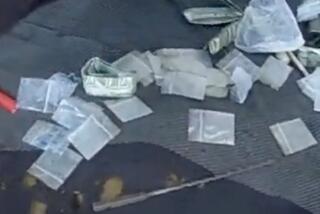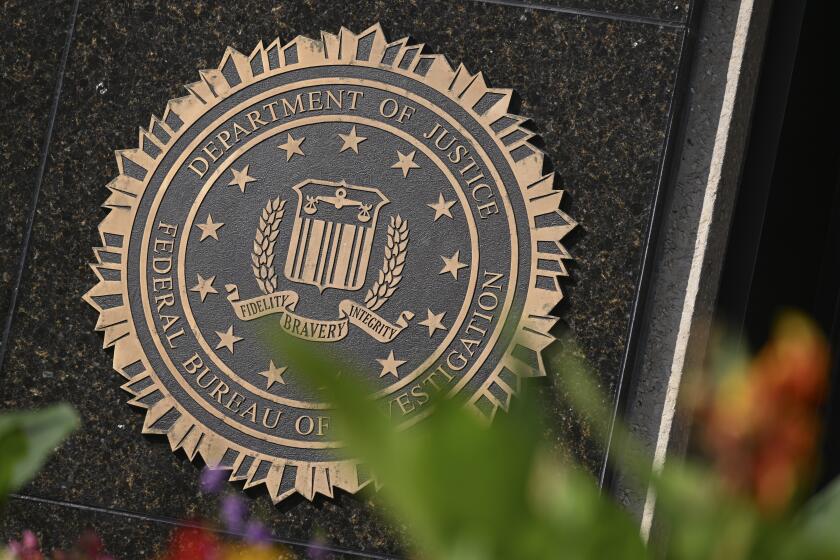Ban on Pesticide Ignored, State Says : Official Vows to Prosecute Growers Involved in Melon Contamination
California’s chief agriculture official voiced “strong suspicions” Monday that San Joaquin Valley watermelon growers ignored a ban on a powerful pesticide, prompting an epidemic of food poisoning and an unprecedented recall of melons.
“I will not sleep until I find these growers,” said Clare Berryhill, director of the state Department of Food and Agriculture. “I am going to use all the police powers I have to put them away. We are going to nail them to the cross.”
Berryhill’s accusations, the strongest yet in an escalating case of food poisoning that broke Thursday, came at a press conference called to announce that grocers and restaurateurs must destroy their watermelon stock and farmers must have their melons tested before sending them to market with special stickers identifying them as edible.
More Sites Identified
Further, Berryhill indicated that researchers had evidence that the pesticide poisoning was broader than first believed, saying they had turned up signs of the toxic pesticide aldicarb in 40 watermelon patches in five San Joaquin Valley counties. Earlier, the epidemic had been linked only to four Kern County growers.
Kern County farmers have said the outbreak, which has afflicted 150 people in California with violent although non-lethal bouts of vomiting, cramps and tremors, was the result of residue from applications of the pesticide in previous years on other crops.
Berryhill discounted this. “I’m not assuming it was a carryover,” he said. “I’m assuming it was an illegal application.”
In making his accusations, Berryhill cited only unnamed “industry informants” and laboratory tests. He said state officials at present “don’t have any evidence” to place culpability on the growers.
Manufacturer’s View
Officials at Union Carbide, the giant chemical firm that manufactures aldicarb and markets it under the brand name Temik, also maintained that it would not be chemically possible for the pesticide to remain in the soil for more than six months. They said the farmers must have applied the chemical despite regulations prohibiting its use on melon crops.
As Berryhill provided the latest volley in a succession of blame-placing, grocers began to destroy their watermelon stock. Most had kept the melons in cold storage since Thursday, waiting for instructions from the state.
Begin Destroying Melons
The markets were told to dispose of the watermelons through ordinary means, rather than sending them to toxic dumps. Vons Grocery Co. spokeswoman Suzanne Dyer said the chain’s California stores began destroying their watermelons late Monday afternoon. Other chains said they would first inventory their stocks before destroying them.
Less clear was what would become of vast quantities of the fruit now bottlenecked at wholesalers’ warehouses. Berryhill indicated it is possible that some of this fruit could make it to market if the wholesalers could prove it came from a field found to be clean of any chemical contamination.
Shipments Halted
Truckloads of watermelons from Arizona, Oklahoma, Mexico and other melon-growing locales have been turned around since the outbreak was announced, county agriculture officials said.
Berryhill estimated that 1 million melons would be affected by the order, a downward revision from earlier estimates of 10 million. He explained that while 10 million melons--about a third of the state’s output--had been harvested so far, the vast majority had been consumed before the epidemic.
Toby Milligan, an official with the Los Angeles County Department of Health Services, said workers would be contacting restaurants that serve watermelons to inform them of the order to destroy their stock.
The order to destroy current watermelon stock also applied to California households. It was said by state officials to be the largest recall of fresh fruit in California history.
Milligan said there have been 49 cases in Los Angeles County of people believed to be afflicted by the tainted melons. Statewide, 149 “presumed” cases of illness caused by watermelons had been reported as of Monday. Another 200 cases were listed as possibly a result of the tainted fruit, officials said.
Other Areas Affected
Three other states and Canada also have reported illnesses linked to watermelons.
No one is believed to have died because of the outbreak, officials said.
Berryhill said he believes as many as seven growers with as many as 23 fields misapplied the pesticide to their watermelon crops within the past 100 days.
Additionally, melons from 20 or more fields in Kern, Fresno, Tulare, Merced and Madera counties--all in the San Joaquin Valley--have tested positive for signs of aldicarb. However, Berryhill downplayed the significance of this, saying the findings were of minuscule amounts and might have been the result of lab error.
Rex Magee, associate director of the Food and Agriculture Department, said findings would be presented to the state attorney general and county district attorneys for review.
Penalties Possible
Magee said farmers could be subject to an unspecified civil penalty or, if convicted of a misdemeanor criminal charge, be placed in jail for six months and fined as much as $1,000 for each contaminated melon.
Since the outbreak, lab workers have been testing watermelons gathered from around the state. Having worked around the clock, they were given the day off Monday.
There are 500 watermelon patches statewide, owned by about 125 farmers.
On Monday, state inspectors returned to the fields to collect 20 sample melons from fields that previously tested negative.
Melons from fields proven to be clean of any contamination will be adorned with a small green and white sticker bearing the words “Passed California Agriculture.” Officials said all melons sold must have this sticker.
Response of Farmers
In Kern County, which has been the focus of the investigation, farmers again reacted with indignation Monday to accusations that they might have willfully violated the pesticide ban.
“I wish I could say this thing was all black and white, but it’s probably colored in shades of gray,” said Loron Hodge, manager of the Kern County Farm Bureau. “I can’t imagine anyone purposefully using this material if they knew it was going to make people sick. That is not what they are in the business for. They are in the business to provide food for peoples’ nourishment and enjoyment.”
Meanwhile, it was learned that a similar outbreak of the illness after
eating watermelons occurred in Kern County in August, 1982. However, it went unreported to the public because of difficulties in proving it was due to tainting of the melons with a pesticide, Dr. Ron P. Hattis, a public health physician who was then Kern County’s assistant health officer, said.
“I am certain that the current outbreak is not a new problem,” he said in an interview. “It’s the same pesticide with perhaps some of the same growers who are responsible.”
Hattis now works at the San Bernardino County Medical Center.
He said the earlier outbreak involved a family of five persons and several other county residents who ate watermelons given to them by the driver of a truck loaded with 20,000 pounds of the fruit on its way to Los Angeles as thanks for their assistance in repairing his rig after it broke down.
Their symptoms were classic for aldicarb-type poisoning, he said, but no public warning was issued because tests for indications of the presence of aldicarb on the patients and some of the melons were negative.
New Tests Available
Today, however, according to the physician, a new test exists that is capable of identifying the presence of breakdown products of aldicarb, which may also be toxic.
Hattis says that if the farmers are rotating melons and cotton on the same land, the issue may be whether it is the long-lasting breakdown products (sulfone and sulfoxide) rather than aldicarb itself that are contaminating the melons.
Evan Evans, a Kern County agriculture official, confirmed Hattis’ account.
Aldicarb has been found in ground water supplies from one end of the country to the other, fueling a debate that has raged on for nearly a decade.
Aldicarb was once considered a godsend by farmers who found it easy to apply and extremely toxic against pests. But the discovery of the pesticide in drinking water in Florida and New York made the substance a cause for concern among some environmentalists, and the contamination of melons in California led the federal Environmental Protection Agency on Monday to announce that it would reexamine the levels of exposure permitted under agency guidelines.
It is considered a dream pesticide by growers because it doesn’t have to be sprayed or applied in a hazardous way. The granular substance can simply be buried at the base of a plant, which absorbs the chemical through its roots.
The chemical is used widely on cotton, sugar beets, potatoes, peanuts and some non-edible plants, but it is not authorized for use on most plants grown for human consumption.
There is some dispute over how unsafe it is for humans. Four environmental toxicologists at Cornell University concluded at the end of a three-year study in 1983 that the potential health hazards had been overstated, but that contention was quickly challenged by 128 New York homeowners who brought suit against Union Carbide. The company was accused of failing to perform adequate research before selling the product.
The pesticide was coming into its own in the late 1970s when potato farmers on Long Island, N.Y., found it extremely effective against the Colorado potato beetle. But by 1980 the EPA banned its use there at the request of Union Carbide after levels had been found in test wells above the state guidelines of seven parts per billion in drinking water.
Similar problems occurred elsewhere, particularly in Florida, Maine and Wisconsin. The pattern in most areas was that the pesticide turned up in areas it was not expected to be found, most notably ground water supplies.
The use of the chemical was banned for awhile in Florida, much to the consternation of citrus growers, who had found it extremely effective against pests, but the ban was lifted in 1983.
Peter H. King reported from Los Angeles, Daniel M. Weintraub from Sacramento. Bob Baker in Kern County and Lee Dye in Los Angeles contributed to this article.
More to Read
Sign up for Essential California
The most important California stories and recommendations in your inbox every morning.
You may occasionally receive promotional content from the Los Angeles Times.











